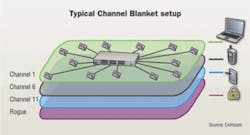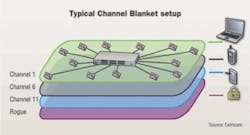How to remove uncertainty from VoWLAN installations
Achieving go-anywhere communication while reducing costs requires overcoming traditional cell-based wireless architectures.
For vendors and end-customers alike, WLAN has become a logical extension of structured cabling, providing flexibility in network deployment while still retaining the robustness of traditional wired networks. As a result, enterprises are starting to look beyond the simple question of "How do we implement wireless?" to the more application-centered question of "How much can we implement on wireless?"
One of the most exciting yet challenging applications is voice over WLAN (VoWLAN). Its advantages are significant and multi-faceted, but ultimately boil down to two considerations: Increased employee mobility and reduced operating expenditures. Enterprises look to VoWLAN to provide communication anywhere on campus, while at the same timegreatly decreasing telecom costs.
But achieving these goals means overcoming some technical hurdles posed by the IEEE 802.11 standard, and the way it has typically been implemented—namely, the cell-based WLAN topology. Traditional cell-based wireless architectures are intrinsically incapable of fully resolving certain technical hurdles, forcing enterprises to look for alternatives. Overcoming these obstacles will go a long way towards making an investment in VoWLAN a sure thing, rather than a gamble with uncertain end results.
An architecture challenge
Many of VoWLAN's challenges can be traced to cell-planning—a wireless architecture in which each access point (AP) transmits on one of the three non-overlapping channels available in the 802.11b/g standard. Cell-based topologies impose cost- and labor-intensive deployments, requiring that APs be carefully positioned and "tuned" to try to avoid the co-channel interference from neighboring APs that can kill transmissions.
Wireless vendors, such as Cisco, Aruba and Trapeze, have invested much time, effort, and budget to resolving these problems. But cell-planned architectures wind up either being optimized for coverage (signal is available everywhere in the enterprise, but not with optimalbandwidth) or capacity (a maximum number of users can have optimal bandwidth, but not everywhere inthe enterprise)—rarely for both at the same time.And neither scenario addresses the underlyingchallenge that VoWLAN requires a fully mobile andhighly resilient, always-on connection to ensure call continuity and toll-quality voice.
No matter what the topology, some fundamental traits of the 802.11 protocol must be factored in when planning aVoWLAN deployment. Understanding and accounting for these basics can go a long way toward eliminating the uncertainty around this technology.
Enterprises look to VoWLAN as a way of increasing employee mobility, meaning continuous communications whiletraveling between point A and B. This might seem obvious,but the fact of the matter is that WLAN does not inherentlysupport mobility; 802.11 "Wi-Fi" is, by definition, designed for portability, meaning communications at point A and B but not continuously between them.
Combine this with traditional WLAN systems that organize access points in a cellular pattern, and you get a network that is simply not optimized for mobility. The basic problem revolves around "handoff," which is what happens as users move through cell-planned WLANs, de-associating from one AP and associating to another as they move. The delay introduced by handoff is usually not a problem for data transmissions but is often a deal-breaker for voice calls. And a dropped call is not a trivial matter when you are rushing to make a "just in time" shipment or help a customer resolve a trouble ticket.
Another VoWLAN "fact of life" is the need for a constant, stable connection rate. In traditional WLANs, the negative impact of such factors as rate adaptation, edge users, coverage holes, and interference was not as strongly felt, since data communication—bursty by nature—can tolerate the widely varying data transmission rates that result from these effects.
Voice users, in contrast, require real-time communications that cannot withstand buffering and retries. Consequently, call quality will suffer greatly if the WLAN does not providerobust coverage and capacity. But it is precisely these two key performance characteristics that cell-based architecturesoften trade off against each other.
Voice and data don't mix well
It is rare for an organization to deploy a wireless system solely to support VoWLAN. Most customers look to maximize the usage they get from their WLAN, and so expect the same system to carry both voice and data traffic. But these two traffic types clash. WLANs have always been data-centric and, even with the advent of new standards (e.g., 802.11e), still have inefficient Quality of Service (QoS)mechanisms for prioritizing voice over data traffic. Truly effective QoS needs to be based on deterministic methods; otherwise, the co-existence of voice and data will be uneasy at best and unworkable at worst.
All of these factors point to a single conclusion: In a cell-based architecture, implementing VoWLAN will inevitably require accepting some degree of uncertainty as to system performance. But successful implementations are not built onuncertainty; eliminating design variables and their asso-ciated project risks is essential to realizing the workforcemobilization potential of VoWLAN.
One alternative that has proved highly successful is the Channel Blanket topology. Eliminating the concept of cell planning, Channel Blanket permits any given Wi-Fi radio channel to be used on every access point to create a continuous "blanket" of coverage for each channel. Using multi-radio APs, the system creates multiple overlapping WLANs from the same physical set of APs.
Furthermore, wireless clients associate directly to the switch, rather than any individual AP, so that the entire constellation of APs is used simultaneously for uplink and downlink communications between client and infrastructure. Since there is only one point of association (the switch), clients move throughout the total service area without experiencingAP-to-AP handoffs.
This unique approach enables IT to define multiple overlapping Channel Blankets, set to any channel, in any band and Wi-Fi mode (a/b/g/n). The bandwidth of each channel is delivered across the entire service area (that is, the combined coverage of all APs connected to the switch), with interference-free operation and consistent capacity throughout, while clientdevices move seamlessly across the entire blanket.
This architecture has two particularly unique benefits for VoWLAN—robust connectivity and seamless mobility:
- Because each VoWLAN client transmission can be heard by multiple APs simultaneously, the problems of connection stability are eliminated, even in harsh environments with multiple external sources of RF interference.
- The fact that the VoWLAN client is associated with the switch means that it is never subjected to AP-to-AP"handoff," making possible zero-latency mobility within the wireless coverage area.
In effect, this level of connection robustness and handoff-free mobility is a result of having all the APs operate like a large distributed antenna, with packet-by-packet routing to ensure that communications are always sent across the best-positioned AP at any point in time.
Another notable advantage to the Channel Blanketapproach is the elimination of QoS contention by separating VoWLAN devices from data devices onto different blankets. Also, from the implementer's perspective, the ease of deployment and maintenance of such systems is a huge benefit of this architecture, since it eliminates the never-ending RF cell planning and "tweaking" complexity of traditional systems.
Casino blanketing
The Channel Blanket concept was recently put through itspaces in the challenging conditions of the playing floor atthe Commerce (CA) Casino, a world-recognized venue for high-stakes, high-profile gaming. From the IT perspective,the Casino is a highly complex environment, with real-time communication needs and sophisticated applicationssupporting business operations.
It was against this background that Ralph Wong,Commerce Casino's chief administrative officer, decided toreplace an obsolete telecommunications system used by pit bosses and a network of supervisors with a new VoWLAN solution supported by an Extricom WLAN system. The criticality of thesystem meant that Wong had to make sure the underlyingWLAN infrastructure could fully support his range ofbusiness requirements.
"It's a two-step process: you need to find the right phone, but you also need the right WLAN infrastructure to support it," says Wong. "For our managers, wherever they are on the floor is where their office is. It's essential that our solution give them the ability to roam freely while still being able to take live calls, which is key to good customer service."
Commerce Casino's complex encompasses 238,000 square feet, and the WLAN had to provide coverage everywhere on the premises as well as capacity for areas where wirelessclients might congregate. At the same time, the solution had to be robust enough to deal with the interference-prone environment of the pit floor, where a variety of wirelessdevices and signal-producing equipment would be jostling for the same airspace.
Cell-based WLANs on the market would be challenged to meet these requirements. These solutions are optimized for coverage or capacity, but not both. Even more important, the frequent handoffs experienced by users as they pass from AP to AP are problematic for supporting mobile voice communications. And from an operations standpoint, the frequent re-tuning required of a cell-based solution makes for a poor choice for such a dynamic environment.
Wong consulted with telecom solution provider Teldata(www.teldata-usa.com), which recommended deploying an Extricom Channel Blanket-based WLAN to support theSpectraLink phones Wong has selected. Teldata wasfamiliar with this architecture from having deployed it inother harsh environments.
"Picture the Channel Blanket like a bubble covering yourfacility," explains Tim Wagner, the wireless consultant working on the project. "The topology allows you to deploy APs anywhere, so if there's a hole in the bubble you just put inanother AP to plug it. Likewise, you can place them in anydensity to ensure uplink diversity, which goes a long waytowards drowning out RF interference from other wireless devices."
Beyond the technology "big picture," small but critical details were key to deploying VoWLAN. According to Wagner, "the Channel Blanket provides a level of QoS that no other architecture can come close to, making VoWLAN deployments really simple."
The Commerce deployment was carried out in two working days by Teldata personnel, maneuvering aroundongoing casino operations without interrupting a single hand of cards. The implementation process essentially consisted of the team walking the floor to become familiar with the site, loading sitemaps to a deployment tool, and determining the best AP placement based solely on signal propagation. There was none of the channelization, IP networking, or coverage overlap and interference analysis required by other solutions. The only remaining steps were to mount the APs, configure the switch in a single event, and perform basic checks toensure they had the complete coverage they were seeking.
Future rewards
Since the implementation, the Casino says its VoWLAN has worked flawlessly. Commerce's managers are now able toremain on the floor from shift start to finish, responding to concerns instantly.
In addition, says Wong, "We selected a Channel Blanketsystem because it's future-proof, and can pretty muchsupport whatever we choose to run on it."
Commerce's next planned WLAN application is a cutting-edge Guest Rewards card that can leverage wireless RFID technology, integrated with a CRM (customer relationship management) system, to give the casino's managementinsights into player preferences. Whatever RFID application is chosen will benefit from the Channel Blanketarchitecture by running in parallel with the VoWLAN phone system, on its own dedicated channel throughout, without competing for the same airspace.
From Wong's perspective, Commerce Casino has already reaped its own share of rewards: "The solution has allowed us to realize substantial savings, and we will achieve considerable operational efficiencies, both now and going forward."
DAVID CONFALONIERI is vice president/marketing at Extricom (www.extricom.com).

